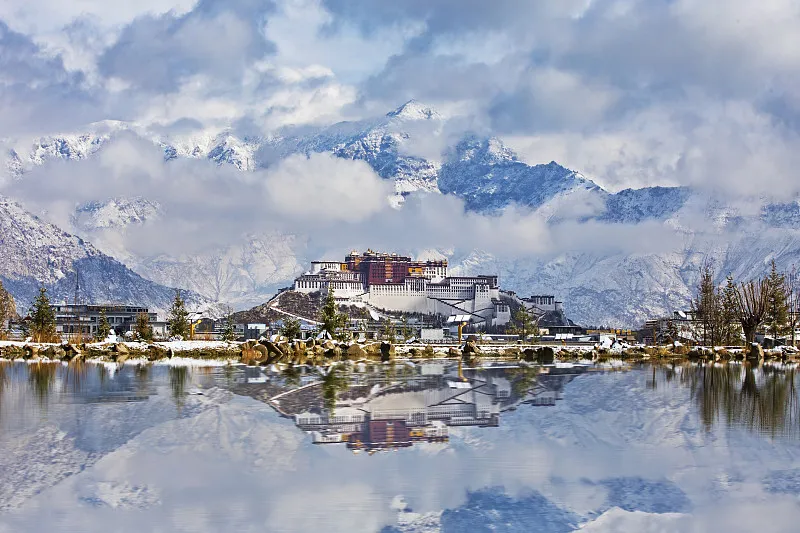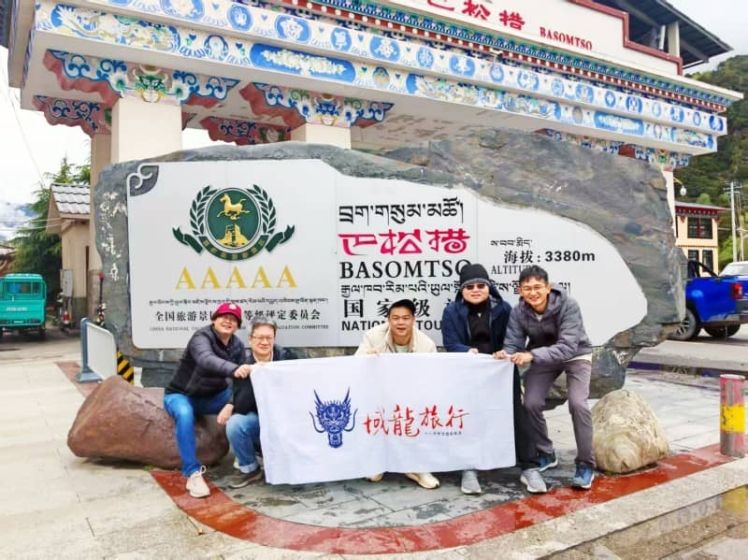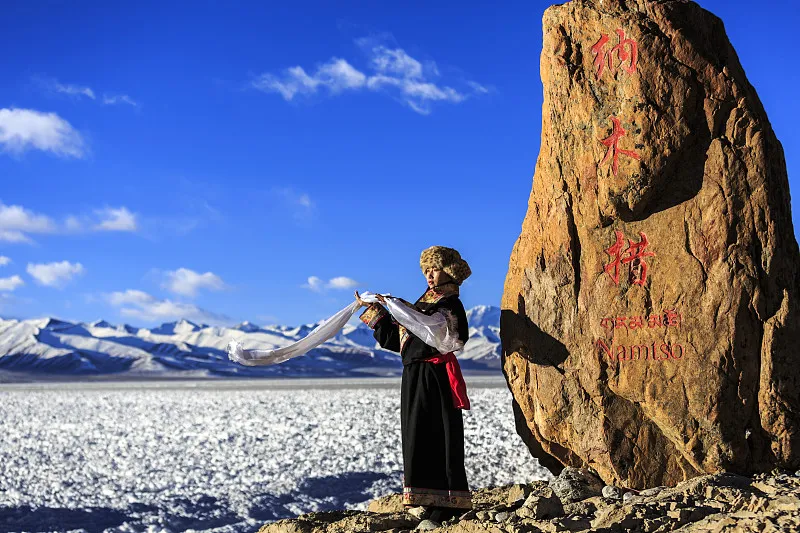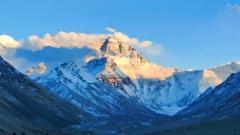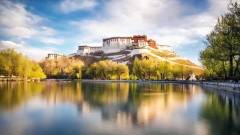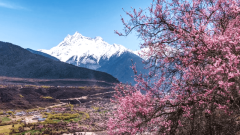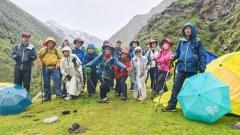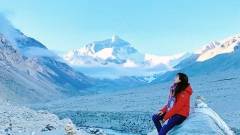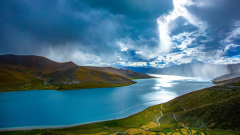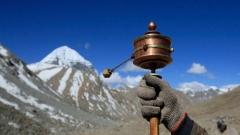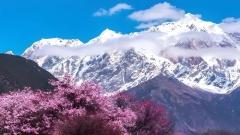If you’ve ever dreamed of standing beneath the majestic ramparts of the Himalayas, trekking across windswept plateaus, or exploring living, centuries-old Tibetan Buddhist traditions, there’s no better moment than 2025 to make that journey a reality. Today, international travelers with a valid passport and a Chinese visa can seamlessly apply for the required Tibet Travel Permit – often using just their passport if they qualify under China’s expanding visa-free policies. Whether you plan to fly into Lhasa, cross overland from Nepal, or combine Tibet with a broader China itinerary, 2025 promises streamlined procedures and plenty of unforgettable experiences. In this comprehensive guide, we’ll explain step by step how to prepare, which documents you need, what safety and health considerations to keep in mind, and how to secure a Tibet trip that aligns perfectly with your interests.
Is It Possible to Visit Tibet in 2025?
The short answer is yes -traveling to Tibet in 2025 is not only possible but easier than ever. Once you hold a valid passport and a Chinese visa, the next critical document you need is the Tibet Travel Permit (TTP). Unlike some years in the past, today you can apply for the TTP using just your passport if you’re coming under China’s visa-free entry program. Even if you don’t qualify for visa-free entry, obtaining a Chinese visa through your local Chinese embassy or consulate is straightforward, and once you have that, you can work with a licensed, local travel agency to secure your Tibet Travel Permit.
In practice, here’s how the process works:
- Obtain a Chinese Visa (if required). Citizens of over 30 countries currently enjoy a 15-day or 30-day visa-free stay in China (which covers Tibet as part of the People’s Republic of China). If you hold one of those eligible passports, you can skip the embassy/consulate step and proceed directly to applying for your TTP. If your passport isn’t on the visa-free list, you’ll need to apply for an L-type (tourist) Chinese visa at your nearest embassy or consulate at least one month before your planned departure.
- Book Your Tibet Tour with a Licensed Agency. In China, personal applications for a TTP are not permitted—you must book a guided tour through an approved local agency. Once you pay your deposit and confirm a departure date, your chosen agency will prepare all local documentation and file the TTP application on your behalf.
- Apply for the TTP. For most travelers, especially those entering under a visa-free program, the only paperwork you need to submit is a scan of your passport’s biographical page. Once the agency receives the digital copy, they will process your TTP, which typically takes anywhere from one to three weeks (though 21 days lead time is recommended to ensure plenty of buffer).
- Travel to Tibet. When your permit is approved, you will receive a PDF or printed copy of the TTP. Present this document—alongside your passport and Chinese visa, if required—when you check in for flights or trains bound for Tibet. From there, your guided group or private tour will begin, and you’ll be free to explore the high plateau under the watchful care of a local guide.
Because 2025 sees a broader expansion of China’s visa-free policy, many travelers find the TTP process simpler than ever. If you hold a passport from a visa-exempt nation, you can apply for Tibet access without obtaining a formal tourist visa, as long as you schedule your visit within the 15- or 30-day window.
Understanding China’s Visa-Free Entry and Its Impact on Visiting Tibet
In recent years, China has introduced a visa-free entry policy for citizens of more than 30 countries—primarily in Europe, East Asia, Southeast Asia, North America, and a handful of other regions. Under this arrangement, eligible travelers can enter China without applying for a traditional L-visa, enjoying either a 15-day or 30-day stay (depending on nationality and port of entry).
How to Leverage Visa-Free Entry to Get Your Tibet Permit
If you qualify for visa-free entry, you can turn your passport directly into a Tibet Travel Permit without stopping first at a Chinese embassy. Here’s what to do:
- Verify Your Nationality’s Visa-Free Eligibility. Before you plan your trip, double-check that your passport country is still on the list. Countries like Germany, France, the United Kingdom, Japan, Singapore, the United States, and Australia are typically included, though policies can shift, so confirm with official sources before proceeding.
- Book Your 15- or 30-Day Slot Wisely. Beijing, Shanghai, Guangzhou, and six other major international airports currently allow you to transit visa-free or enter visa-free. Plan to fly in through one of these airports. Your clock for visa-free days starts when you land, and you must apply for your TTP (or any other internal permits, such as entry into Xinjiang or Inner Mongolia) within that window.
- Schedule a Guided Tour Immediately. Since individual permit applications are not permitted, you need to partner with a licensed Tibetan travel agency right away. Once you pay a deposit and provide your passport scans, they will file your TTP.
- Ensure You Apply for the TTP No Later Than Day 15 (or Day 30). The permit-issuing office can process most TTP applications within 10–14 days, but it’s safest to allow 21 days before your intended departure for Tibet. That way, if there are any holdups or quizzes due to peak season demand, you still remain within your visa-free window.
Recommended Tibet Tours for 2025 Visa-Free Travelers
Depending on whether you have a 15-day or 30-day visa-free allowance, you can choose from a variety of itineraries that highlight Tibet’s most iconic destinations:
8-Day Lhasa to Everest Base Camp Tour:
- Highlights: Potala Palace, Jokhang Temple, Sera Monastery; passing through Gyantse; arriving at Rongbuk Monastery for panoramic views of Everest’s north face; overnight near the base camp at 5,200 meters.
- Ideal for: Travelers with a 15-day visa-free window who want to maximize every moment and still return to mainland China with a day to spare.
10-Day Classic Tibet Explorer (Lhasa, Everest, Namtso):
- Highlights: In addition to Lhasa and Everest, this tour includes Lake Namtso, one of the holiest and highest saltwater lakes in the world (4,718 meters). Enjoy a lakeside night under starlit skies and soak in the reflection of snow-capped peaks on turquoise waters.
- Ideal for: Visa-free visitors with 15 days who want a well-rounded taste of cultural sites, high-altitude scenery, and spiritual ambiance.
13-Day Mount Kailash and Everest Overland Expedition:
- Highlights: After exploring Lhasa’s monasteries, journey westward across the Tibetan Plateau to Mount Kailash (6,638 meters) and Lake Manasarovar. Complete the sacred Kailash Kora (52-kilometer pilgrimage circuit) over three days, then continue northeast to Everest.
- Ideal for: Adventurers granted a 30-day visa-free stay, as this ambitious itinerary requires at least 15 days for Kailash alone, plus 8–9 days for Everest, with buffer days for acclimatization.
15+-Day Ultimate Tibet Expedition (Beijing/Shanghai + Tibet):
- Highlights: Combining a week in Beijing or Shanghai with a 10-day Tibet tour (Lhasa, Everest, Kailash, Namtso), this extended journey allows you to see China’s modern marvels before ascending to the “Roof of the World.”
- Ideal for: Holders of a 30-day visa-free pass who wish to experience multiple facets of Chinese culture—ancient, contemporary, and Tibetan – without needing a formal Chinese visa.
No matter which route you choose, the window to apply for the TTP must fall within your 15-day or 30-day visa-free period. A reputable local agency can manage all the permit paperwork so that you can focus on packing warm layers and photographing prayer flags fluttering against azure skies.
Do You Need a Chinese Visa to Visit Tibet in 2025?
If your nationality is not on China’s visa-free list, you must obtain a Chinese Tourist (L Type) Visa before your trip. Fortunately, the procedure is quite straightforward:
- Locate Your Nearest Chinese Embassy or Consulate. In most countries, this is an independent diplomatic mission. Check official embassy websites for up-to-date visa application forms.
- Gather Required Documents. Generally, you will need:
- A valid passport with at least six months of remaining validity and two blank pages.
- A completed visa application form (downloadable from the embassy’s website).
- A recent passport-style photo (colored, white background).
- Proof of round-trip flight reservations or confirmed China tour bookings. Some consulates may also require an invitation letter from a travel agency or travel confirmation with itinerary.
- Submit Your Documents and Pay the Visa Fee. Visa fees vary based on nationality and local consulate regulations. Processing time typically ranges from 4–7 business days (standard service), though expedited services are often available for an extra fee.
- Collect Your Visa Sticker. Once the visa is approved, you will receive a visa sticker in your passport that allows you to enter China for tourism. Most tourist visas are valid for 6 months and permit single-entry or double-entry stays of up to 30 days per entry.
Once you hold this Chinese visa, you can apply for your TTP at any point during its validity—provided you have booked your Tibet tour with a licensed agency and supplied all requisite documentation.
Applying for Your Tibet Travel Permit: Step by Step
For all foreigners (with or without a Chinese visa), the Tibet Travel Permit (TTP) is the single most important document you need. Here’s a detailed breakdown of how and when to apply:
- Book Your Tibet Tour with an Approved Agency (Most Commonly China Dragon Travel). Because individual permit applications are not allowed, you must contract with a local agency that holds the necessary permits to file on your behalf. Pay your deposit (often 20–30% of your total trip cost) and finalize your travel dates.
- Submit Copies of Your Passport (and Chinese Visa, if Applicable).
- If you’re a visa-exempt traveler, your agency will file the TTP using your passport information alone.
- If you hold a Chinese visa, provide a clear scan of both the passport page and the visa page.
- Allow at Least 21 Days for Processing. While some permits can be ready in as few as 10 days, peak travel seasons (spring and autumn) can delay processing. To be safe, submit your documents at least three weeks before your intended entry into Tibet.
- Receive Your TTP. When everything is approved, your agency will send you a digital PDF of the TTP. Print at least two color copies—one to present when boarding trains/planes, and one to keep as backup. Without this document, local authorities in Chengdu, Lhasa, or Kathmandu will not let you board your connecting flight or train.
- Present Your TTP at the Border or Departure Gate.
- From Mainland China (e.g., Chengdu, Xi’an, Chongqing): Show your TTP at the domestic check-in counter for flights or trains bound for Lhasa, Shigatse, or Nyingchi.
- From Nepal (e.g., Kathmandu): Upon arrival at Zhongba (Gyirong) or Kerung/Rasuwa at the China-Nepal border, present your TTP to Chinese immigration. Then continue by bus or private vehicle to Lhasa.
As soon as you reach your first Tibetan city—most likely Lhasa—local police stations will register your entry, after which you can travel freely within the Tibet Autonomous Region (TAR).
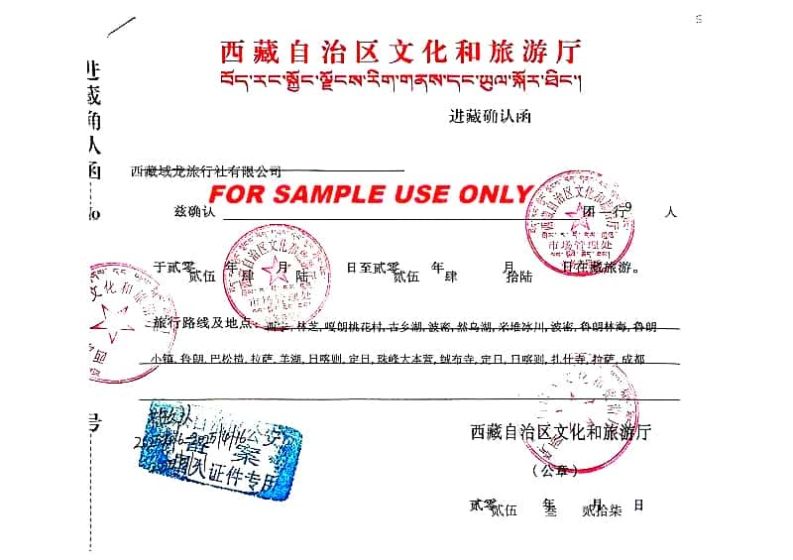
Tibet Travel Permit
Is Tibet Safe to Travel to in 2025?
Safety is a top concern for anyone planning a high-altitude expedition. Rest assured, Tibet remains one of the safest destinations in Asia, thanks to stable local governance, low crime rates, and welcoming communities. Here are the key points regarding safety in 2025:
- Political Stability: As of 2025, the Tibetan Autonomous Region continues to maintain strict security measures, ensuring safe passage for tourists. Foreign travelers can move freely with valid permits; there are no travel restrictions within TAR towns and major roads, provided you remain on your guided itinerary.
- Low Violent Crime: Petty theft is rare, and violent crime against foreigners is virtually unheard of in urban centers like Lhasa or regional towns like Gyantse and Shigatse. Courteous locals and responsible authorities make the environment very traveler-friendly.
- Road and Travel Safety: Tibetan roads can be winding and remote. While the scenic Qinghai-Tibet Highway (G109) and Lhasa-Shigatse Expressway are generally well-maintained, winter road closures can occur due to heavy snowfall. If traveling by road, choose a reputable driver and vehicle; most travel agencies use modern, 4-wheel-drive coaches equipped for high-altitude conditions.
- Health-Related Concerns: The only significant risk factor in Tibet is altitude sickness (acute mountain sickness, or AMS). Because most famous destinations—including Lhasa (3,650 m), Everest Base Camp (5,200 m), Namtso Lake (4,718 m), and Mt. Kailash (5,200 m)—are located at very high elevations, acclimatization and basic health precautions are essential.
In short, if you prepare properly and heed local advice (especially regarding altitude), you’ll find Tibet to be a remarkably secure place to experience some of the planet’s most breathtaking natural and cultural treasures.
Altitude Sickness: How to Stay Healthy in High-Altitude Tibet
Since much of Tibet sits well above 3,000 meters (9,842 feet), altitude sickness is a reality for many international visitors. However, with the right preparation and attentive listening to your body, you can minimize discomfort and truly enjoy your high-plateau adventure. Here’s how:
Understand the Symptoms of AMS
- Mild AMS: Headache, nausea, dizziness, fatigue, difficulty sleeping.
- Moderate AMS: Worsening headache, vomiting, shortness of breath with exertion, inability to walk uphill without stopping.
- Severe AMS (HAPE/HACE): Shortness of breath at rest, cough with frothy sputum (HAPE—High Altitude Pulmonary Edema), confusion, lethargy, inability to walk or coordinate movements (HACE—High Altitude Cerebral Edema).
If you or any member of your group experiences moderate to severe symptoms, immediate descent (even a few hundred meters) and medical attention are crucial.
Acclimatization Tips
- Ascend Gradually: If possible, avoid traveling directly from low-elevation cities (e.g., Beijing, Shanghai, Kathmandu) to Lhasa in a single day. Instead, consider an overnight stop at an intermediate elevation—such as Shigatse (3,900 m) or Gyantse (3,950 m)—before reaching Lhasa (3,650 m). This “climb high, sleep low” approach allows your body to adapt over 24–48 hours.
- Stay Hydrated: Drink at least 3–4 liters of water daily to help your body adjust. Dehydration can worsen AMS symptoms.
- Avoid Strenuous Exercise for the First 48 Hours: Plan light activities (e.g., strolling around Lhasa’s Barkhor Street or visiting Sera Monastery) during your first two days. Save hikes and more ambitious excursions (like Everest Base Camp) for after a brief acclimatization period.
- Eat Carbohydrates and Light Meals: Easily digestible foods—rice, noodles, soups—provide quick energy without overtaxing your digestive system.
- Consider Medication: Speak with your doctor about acetazolamide (Diamox), which can speed acclimatization. If you experience mild headaches or nausea, over-the-counter pain relievers (e.g., ibuprofen) may help, but never push through moderate to severe symptoms.
Local Medical Resources
Major cities in Tibet like Lhasa and Xigaze (Shigatse) have modern hospitals equipped to handle altitude emergencies. For remote trekking routes, many guided tour operators carry supplemental oxygen, portable hyperbaric chambers (Gamow bags), and basic first-aid kits. Always ensure your travel agency knows your health history and has an emergency evacuation plan in place—especially if you plan to trek to remote areas like Mount Kailash or Ngari Prefecture.
Essential Documents for Traveling to Tibet
Beyond visas and permits, preparing for a Tibet trip requires careful attention to timing, wardrobe, and physical readiness.
- Passport: Valid for at least 6 months beyond your planned return date, with at least two blank pages.
- Chinese Tourist Visa (if applicable): Ensure it’s valid for your entire Tibet itinerary.
- Tibet Travel Permit: Applied through a licensed agency at least 21 days prior to your intended entry date. Carry at least two printed color copies.
- Additional Permits (If Needed):
- Aliens’ Travel Permit (ATP): Required for non-Chinese travelers visiting Ngari (Ali) Prefecture (includes Mount Kailash). Your agency will typically help you secure this.
- Military Permit (May be Required): For certain border-region excursions (e.g., Muztagh Ata area in western Tibet), you may need a special military or police permit. Consult your travel agency if you plan off-the-beaten-path routes.
- Travel Insurance: Confirm your policy covers high-altitude trekking, medical evacuation, and trip cancellation. Keep a digital and paper copy of policy details.
Ideal Time for Tibet Travel in 2025
Tibet’s climate is extreme, with large daily and seasonal temperature swings. Your choice of travel season will shape your overall experience:
- Spring (April to Early June): Snow begins to melt; wildflowers bloom on lower hillsides; clear skies—an excellent time for sightseeing and high-altitude treks. Expect daytime highs of 10–18°C in Lhasa.
- Summer/Monsoon (Mid-June to August): Frequent afternoon showers in lower regions; heavy rainfall can lead to landslides on some mountain roads. However, the high plateau (above 4,500 m) sees less rain, making it possible to trek. Daytime highs around 15–20°C in Lhasa.
- Autumn (September to Early November): Clear skies, stable weather, and luminous sunsets. This is the most popular season for tourism, with daytime highs of 8–15°C and minimal precipitation—perfect for Everest expeditions and Mount Kailash pilgrimages.
- Winter (Late November to March): Bitter cold at high altitudes (below –10°C even in Lhasa). Many remote roads close due to snow. If you can brave the chill, pilgrimage sites are virtually empty, and the mountains are especially photogenic under fresh snow.
For first-time visitors, late April through early June or September through mid-October are ideal. During these windows, you can avoid the heaviest monsoon rains and the bitter chill of winter while still enjoying clearer skies and more stable conditions.
Packing Essentials for High-Altitude Comfort
- Layered Clothing: Temperatures can swing from –5°C (sleeping in Lhasa at night) to +18°C (sunny afternoons). Bring a moisture-wicking base layer, a fleece or down mid-layer, and a windproof/waterproof outer shell.
- Insulated Jacket: A lightweight down parka (that packs into its own pocket) is invaluable for unexpectedly frigid mornings at high camps or dawn visits to sacred sites.
- Sturdy Hiking Boots: Waterproof, ankle-supporting boots break in more easily and help prevent blisters on rocky or uneven trails.
- Warm Hat, Gloves, and Scarf/Neck Gaiter: At altitudes above 4,000 meters, the sun may be strong, but wind chill can drop perceived temperatures drastically once the sun sets.
- Sunglasses with UV Protection: The high plateau’s thin air increases UV exposure. Good sunglasses help prevent snow blindness.
- High-SPF Sunscreen and Lip Balm: At 3,500–5,000 meters, the sun’s rays can burn swiftly—reapply often.
- Reusable Water Bottle with Filter or Purification Tablets: Staying hydrated is essential for acclimatization, and mountainous regions may not always provide reliably clean water.
- Basic First-Aid Kit: Include bandages, antiseptic, altitude sickness medication (acetazolamide if prescribed), pain relievers, and any personal prescriptions.
- Travel Adapter and Portable Charger: Plug sockets in hotels can be scarce, especially in smaller towns. A portable power bank ensures your camera, phone, and GPS stay charged.
With these essentials in your backpack, you’ll be well prepared to handle Tibet’s shifting weather and high-altitude challenges.
What to Expect on Arrival: Your First Days in Tibet
When you finally step off the plane at Lhasa Gonggar Airport (3,570 m) or disembark from the train at Lhasa Railway Station (3,656 m), a sense of otherworldly beauty washes over you: crisp air, prayer flags fluttering in the wind, and distant peaks painted gold by sunrise. However, the first few days are critical for acclimatization and cultural orientation.
Airport/Train Station Procedures
- Show Your Tibet Travel Permit (TTP) at Immigration. Chinese immigration officers will confirm your TTP and check your passport/visa if applicable.
- Luggage Scanning and Security Checks. As with any major airport, you’ll pass through X-ray machines and metal detectors. Keep any prohibited items (sharp objects, large amounts of liquid) in checked baggage.
- Transfer to Your Hotel in Lhasa. Most local agencies provide an airport/train station pickup. Your driver and guide will greet you, help transfer your luggage, and assist you to your accommodation in downtown Lhasa.
Light Activities on Day 1–2
To minimize altitude discomfort, your guide will likely suggest a relaxed schedule for your first two days:
Day 1:
- Check-in at your hotel or guesthouse. Rest, hydrate, and avoid strenuous exertion.
- Short walk around Barkhor Street, exploring local handicraft shops, small cafes, and wandering pilgrims circling the Jokhang Temple. This gentle stroll (3,650 m) helps your body adapt to thinner air.
- Avoid alcohol, tobacco, and heavy meals. Instead, savor a bowl of tsampa (roasted barley flour) or mild soups to keep your digestive system happy.
Day 2:
- Visit Potala Palace—but ascend slowly. The palace sits at 3,700–3,900 m, so take your time climbing the steps, pausing to catch your breath and soak in the panoramic views of Lhasa.
- Explore Sera Monastery in the afternoon, where you can witness lively monk debates—an excellent, low-impact way to immerse yourself in Tibetan culture.
- Early dinner, early bedtime. Your body will appreciate the extra rest as it continues to acclimate.
By mid-day three, many visitors report feeling significantly better, ready to tackle destinations like Drepung Monastery, the holy Yamdrok Lake, or, if you’re en route to Everest, mountain passes that begin at 4,500 meters.
Exploring Lhasa: Must-See Cultural Sites
Once you’ve acclimatized, Lhasa serves as an ideal introduction to Tibetan art, architecture, and spirituality. Make time for these iconic attractions:
-
Potala Palace (3,700–3,900 m):
- Highlights: Built in the seventeenth century by the Fifth Dalai Lama, this former winter palace stands eleven stories high with over a thousand rooms. The white and red palaces contain chapels, stupas, and thousands of Buddhist artworks.
- Tip: Purchase tickets several days in advance—entrance is strictly ticketed to limit daily visitors. Guided tours provide insight into frescoes, intricate mandalas, and the Dalai Lamas’ final resting places.
-
Jokhang Temple (3,650 m):
- Highlights: Considered the most sacred temple in Tibet, the Jokhang houses the Jowo Shakyamuni statue, believed to have been brought to Lhasa in the seventh century.
- Tip: Join local pilgrims who perform koras (ritual circumambulations) around the temple courtyard—clockwise direction, spinning prayer wheels and chanting mantras. Be respectful and maintain a quiet demeanor inside the main prayer hall.
-
Sera Monastery (3,810 m):
- Highlights: One of the “great three” Gelugpa universities, Sera is famed for daily monk debates, held on the monastery’s courtyard at 3 PM from March to October (weather permitting).
- Tip: Arrive around 2:30 PM to secure a spot in the back. Respectful silence (aside from the monks’ chanting) allows you to fully engage with this lively educational tradition.
-
Drepung Monastery (3,800 m):
- Highlights: Once the largest monastery in the world, Drepung was home to over 10,000 monks. Its sprawling complex covers multiple hillsides; guided tours reveal hidden chapels, nooks of gold-leafed statues, and stunning views of the Lhasa Valley.
- Tip: Start early to avoid crowds and catch morning light filtering through prayer halls.
-
Norbulingka (3,704 m):
- Highlights: Meaning “Treasure Garden,” this sprawling summer palace of the Dalai Lamas features manicured lawns, pavilions, and ornate architecture. The onsite museum explains the palace’s evolution from a 1755 pleasure garden to a political center.
- Tip: If your visit coincides with Shoton Festival (August), Norbulingka hosts an unveiling (Tangka) ceremony of a giant thangka painting depicting Buddha’s life—an extraordinary sight.
Exploring these sites over 2–3 days provides a solid foundation in Tibetan Buddhism, monastic life, and traditional artistry—an invaluable introduction before venturing into Tibet’s remote regions.
Venturing Beyond Lhasa: Regional Highlights
After soaking up Lhasa’s vibrant spiritual pulse, your itinerary may take you to numerous other must-visit locales across the Tibetan plateau. Below are some top destinations often included in 2025 itineraries:
1. Shigatse and Gyantse (Central Tibet)
- Gyantse (3,977 m): Famous for Gyantse Dzong (a hilltop fortress with nine kings’ tombs) and the Pelkor Chode Monastery, featuring the largest Kumbum stupa in Tibet—twelve stories with 108 chapels housing thousands of statues.
- Shigatse (3,836 m): The second-largest city in Tibet and home to Tashilhunpo Monastery, seat of thePanchen Lama. Explore the golden stupa of Jowo Shakyamuni, expansive prayer halls, and quiet courtyards.
2. Yamdrok Lake (4,441 m) and Nakchu (Northern Tibet)
- Yamdrok Lake: One of Tibet’s three sacred lakes, famed for its turquoise waters and dramatic mountain reflections. Many itineraries include a stop here for photos and short walks on the lakeshore.
- Nakchu (4,500–5,200 m): Moving north into the central Tibetan plateau, you experience a high desert environment—flat expanses dotted with small nomadic camps. Nakchu is ideal for spotting wild yaks, tibetan antelope, and winter-hardy wildflowers.
3. Everest Base Camp (5,200 m) Region
- Tingri (4,350 m): A small town serving as a gateway to Everest’s north face. On clear days, the mountain’s summit is visible from Tingri as you travel north.
- Rongbuk Monastery (5,005 m): The world’s highest monastery, famed for sunrise over Everest’s north wall. Monks continue daily prayers here despite the harsh altitude.
- Everest Base Camp (5,200 m): Though not a settlement (just tents and a few basic shelters), the Base Camp offers an unbeatable vantage point. On exceptionally clear mornings, you can watch Everest’s summit glow gold as dawn breaks.
4. Mount Kailash and Lake Manasarovar (Western Tibet)
- Mount Kailash (6,638 m): Sacred to Hindus, Buddhists, Jains, and the Bon tradition alike, many pilgrims perform a 52-kilometer kora around Kailash over three days, believing circumambulation leads to spiritual purification.
- Lake Manasarovar (4,588 m): Pilgrims gather at its pristine shores—often taken as the purest freshwater lake on Earth. Bathing in its icy waters is considered a cleansing rite before beginning the kora around Kailash.
5. Namtso Lake and Tsedang (South-Central Tibet)
- Lake Namtso (4,718 m): One of the highest saltwater lakes globally, famous for dramatic icebergs in spring and summer wildflower meadows on its southern shore. The lakeside Tashi Dor Peninsula hosts small hermitages where monks practice meditation.
- Tsedang (2,950 m): A verdant town sometimes called the “Valley of Yamdrok” for its lower elevation and subtropical climate relative to Lhasa. Tsedang features the Yumbulagang Palace (considered Tibet’s first palace) and the Samye Monastery, a 12th-century Buddhist university built in a mandala shape representing a plowed ox.
Including any of these regions in your 2025 itinerary depends on your available time, budget, and interest in either high-altitude challenges or cultural discoveries. Whether you choose the classic Lhasa-Everest route or venture deep into western Tibet’s sacred sites, an experienced local guide can tailor each leg of the journey to maximize your comfort and enrich your understanding.
Tibet’s Culture, Cuisine, and Festivities
Traveling in Tibet is not simply about acclimatization or permits—immersing yourself in local customs, sampling Tibetan cuisine, and experiencing annual festivals deepen your understanding of this unique land.
Tibetan Cuisine: Fuel for the High Plateau
- Tsampa (Roasted Barley Flour): The staple food of Tibetans. Often mixed with butter tea to form small dough balls—nutritious and quick to digest at high altitude.
- Butter Tea (Po Cha): Made from black tea leaves, yak butter, and salt, this creamy beverage helps combat cold and provides essential calories. If the saltiness surprises you, dilute it slightly or add sugar at first.
- Momos (Dumplings): Tibet’s famous dumplings—usually stuffed with meat (yak, beef) or vegetarian fillings like cheese and spinach. Pan-fried or steamed, they’re popular snacks served with spicy chili oil.
- Thenthuk (Noodle Soup): A hearty, hand-pulled noodle soup with vegetables and meat. Perfect for warming up after a chilly morning at high altitude.
- Tsampa Soup (Seppa): Barley flour boiled in water or yak broth, often served with bits of dried meat, onions, and hot chili. A warming comfort food resembling porridge.
- Yak Meat and Yak Butter: Yak products play a central role—yak steaks, yak jerky, and yak butter for cooking. Yak butter tea and yak butter tea cakes are local variations that travelers often find intriguing.
Cultural Etiquette and Customs
- Koras (Pilgrim Circuits): Many Tibetan towns and monasteries have specific circumambulation routes (e.g., Barkhor Street around Jokhang Temple, Kora around Mount Kailash). When performing a kora:
- Walk clockwise around the site.
- Spin prayer wheels on your right side.
- Keep a respectful silence or chant “Om Mani Padme Hum” softly if desired.
- Monastery Etiquette:
- Remove hats and sunglasses before entering prayer halls.
- Always walk clockwise around stupas and Buddha statues.
- Ask permission before photographing monks or religious ceremonies.
- Avoid stepping on threshold stones; these often represent sacred boundaries.
- Speech and Tipping:
- Tibetans are polite and often reserved. A simple nod, smile, or “tashi delek” (Tibetan greeting) goes a long way.
- Tipping temple monks is not customary. Instead, donate modest amounts (often a few RMB or local currency equivalent) in monastery donation boxes.
- Dress Code:
- Modest attire—covering shoulders and knees—shows respect at religious sites.
- Remove hats when indoors, especially in temples.
By learning a few basic Tibetan phrases (e.g., “Ka la” for “thank you,” pronounced like “kah lah”), you endear yourself to locals and demonstrate respect for their heritage.
Festivals You Might Encounter in 2025
Tibet’s festival calendar is rich, reflecting deep spiritual traditions and historic events. Timing your visit to coincide with a festival can be a transformative experience:
- Saga Dawa: Commemorating the birth, enlightenment, and passing of Buddha Shakyamuni. Held in May or June (fourth month of the Tibetan lunar calendar), devotees pilgrimage to Lhasa, engage in kora, and offer butter lamps in monasteries.
- Shoton Festival (Yogurt Festival): Held in summer (around August); includes opera performances, exhibitions of giant thangka paintings, and communal yogurt feasts in Norbulingka (Lhasa’s summer palace).
- Cham Dances: Sacred masked dances performed at monasteries like Tashilhunpo (Shigatse) or Ganden (Lhasa) on various dates throughout the Tibetan lunar year. The dancers symbolize the expulsion of evil spirits and blessings for spectators.
- Lhabab Duchen: Celebrating Buddha’s descent from heaven, usually in October, with special ceremonies at Jokhang Temple involving monks and lay devotees.
- Butter Lamp Festival (Chunga Choepa): Held on the 15th day of the first Tibetan month (around February), when devotees light thousands of butter lamps inside and outside monasteries.
If you plan your 2025 Tibet itinerary around these festivals, remember that:
- Accommodation Bookings Fill Up Quickly. Hotels and guesthouses near major monasteries sell out months in advance.
- Crowds Are Denser, and Permits May Experience Short Delays. Authorities process permits in smaller batches during festival season, so apply even earlier if possible.
- Prices May Fluctuate. Peak-season surcharges on lodgings and transport may apply.
Even if you arrive outside festival dates, you’ll still witness daily religious rituals—monks chanting in prayer halls, pilgrims prostrating at holy sites, and smoke from butter lamps drifting through temple courtyards.
Booking Your Tibet Tour in 2025: Why Trust China Dragon Travel
With dozens of agencies claiming to offer the “best Tibet experience,” how do you choose the right partner? Here’s what sets a well-established operator like China Dragon Travel apart:
- Local Expertise and Licensing:
- Offices in Lhasa and Chengdu guarantee that you work with guides who know Tibetan terrain, cultural protocols, and permit procedures inside and out.
- As a fully licensed TAR agency, China Dragon Travel has direct access to the local Permit Bureau, ensuring your TTP is prioritized—especially during peak months.
- Customized Itineraries & Flexibility:
- Whether you seek a small group departure or a fully private, customizable journey, the agency’s decades of experience allow it to tailor an itinerary that fits your timeframe, budget, and personal interests (monastery-oriented, photography-focused, high-altitude trekking).
- They understand that delays happen. If a flight to Lhasa is canceled due to weather, they have contingency plans—train rerouting, hotel backup, or shifting the schedule by a day to keep you safe and comfortable.
- Safety & Medical Readiness:
- China Dragon Travel provides trained Tibetan guides who carry first-aid kits, supplemental oxygen, and have direct lines to local hospitals in case of emergencies.
- Their drivers are accustomed to high-elevation roads, sudden weather changes, and mechanical issues at altitude. Regularly maintained vehicles and fuel-stop strategies keep breakdowns to a minimum.
- Transparent Pricing & Reliable Refund Policies:
- Their 2025 pricing for small group tours starts at competitive levels, with transparent breakdowns for accommodations, ground transport, permits, and guide fees. No hidden costs appear last minute.
- If unforeseen circumstances force cancellations, their flexible policy allows you to defer deposits or obtain partial/full refunds (depending on timing), minus non-refundable third-party fees for flights, trains, or hotels.
- 24/7 Support Channels:
- Available via WeChat, WhatsApp, phone, or email, the support team offers real-time assistance. Whether you forget to pack warm gloves or need to adjust your arrival date, their responsive customer service ensures nothing falls through the cracks.
By choosing China Dragon Travel as your 2025 Tibet specialist, you gain peace of mind—knowing that local experts handle everything from permit paperwork to high-altitude health checks, allowing you to focus on savoring every moment in the “Land of Snows.”
How to Book Your Tibet Tour in 2025: A Quick Checklist
Before we wrap up, here’s a concise, step-by-step checklist to lock down your 2025 Tibet adventure:
- Confirm Travel Dates & Passport Validity.
- Ensure your passport has at least six months of remaining validity beyond your intended return date.
- Decide whether you’ll travel during spring, summer, autumn, or winter (see Section 7).
- Determine Visa Requirements.
- Check if your nationality qualifies for China’s 15- or 30-day visa-free stay. If so, you can bypass the traditional visa process.
- If not, gather documents and apply for a Chinese Tourist (L) visa well in advance (4–6 weeks recommended).
- Select a Licensed Tibet Travel Agency (e.g., China Dragon Travel).
- Browse their 2025 tour catalog, comparing small group departures and private, customized journeys.
- Request detailed itineraries, pricing breakdowns, and available departure dates.
- Pay Deposit & Submit Scans.
- Once you decide on an itinerary, pay the required 20–30% deposit to lock in your spot.
- Send a clear scan of your passport’s biographical page (and Chinese visa page, if applicable).
- Apply for the Tibet Travel Permit (TTP).
- Your agency will file your TTP application within 48 hours of receiving your deposit and scans.
- Allow at least 21 days for processing, especially if you travel during peak months.
- Finalize Pre-Departure Details.
- Complete your China visa process if required.
- Purchase comprehensive travel insurance covering high-altitude trekking and medical evacuation.
- Confirm hotel and transportation details; secure any additional permits (e.g., ATP for Mount Kailash).
- Pack your high-altitude gear (see Section 13 for details).
- Receive & Print Your TTP.
- Print at least two color copies. Keep one with your passport and hand the other to your guide or lodge for backup.
- Enjoy Your Tibet Journey.
- Arrive at Lhasa Gonggar Airport or Lhasa Railway Station. Show your TTP (and Chinese visa, if applicable) to immigration officers.
- Acclimatize in Lhasa for 1–2 days, enjoying gentle sightseeing at Potala Palace and Jokhang Temple.
- Continue to other regional sights—Everest Base Camp, Mount Kailash, Lake Namtso—under the care of your experienced Tibetan guide.
- Weather Delays & Contingencies.
- Be prepared for last-minute changes: weather in high-altitude Tibet can cancel flights or close roads.
- Maintain communication with your agency so they can make alternate arrangements (trains, overland transfers, or flexible hotel bookings).
- Post-Trip Options.
-
- If you must postpone, consult with your agency about deferring your deposit.
- If you decide to cancel, request a refund according to their stated policy—bearing in mind any nonrefundable third-party charges (flights, trains).
With these steps complete, 2025 will be the year you embark on an extraordinary expedition to Tibet—a place where azure skies meet rugged peaks, where centuries-old monasteries echo with chants, and where the “roof of the world” invites you to experience a blend of natural grandeur and spiritual depth.
Final Thoughts and Your Call to Adventure
Traveling to Tibet in 2025 is not only feasible but offers a once-in-a-lifetime confluence of modern convenience and timeless majesty. With China’s expanding visa-free policy, an efficient TTP process, and top-tier local agencies ready to handle every detail, there is no better moment to explore this enigmatic land.
Contact China Dragon Travel today to start your 2025 Tibet adventure. Let them handle every permit, hotel booking, and high-altitude precaution, while you focus on discovering why Tibet has captured hearts and spirits for millennia. In 2025, Tibet awaits—an odyssey unlike any other.



